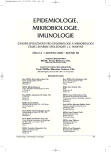A Day to Focus; and Act; on Pneumonia
Vyšlo v časopise:
Epidemiol. Mikrobiol. Imunol. 58, 2009, č. 4, s. 197
Kategorie:
Zprávy
Every year, two million children die of pneumonia, the world’s leading infectious child killer [1]. The disease claims another young life every 15 seconds; more than measles, malaria and AIDS combined [2]; yet many clinicians, health workers and policy makers remain unaware of the scale of this preventable epidemic. The New York Times recently dubbed pneumonia the “orphan of global health.”
The first World Pneumonia Day; launched by a coalition of child health organizations, including the Sabin Vaccine Institute’s Pneumococcal Awareness Council of Experts (PACE); to raise awareness of this public health crisis and spur urgent action to address it takes place on November 2nd 2009. Pneumonia deaths in children are largely unnecessary and an example of a sizeable health inequity because more than 2,000 children in developing countries die for every one child that dies of the disease in an industrialized country [3]. As such, it is critical that as doctors and scientists we lend our voices and networks to the fight.
While early diagnosis and treatment can save lives, vaccines are the single most effective way to prevent pneumonia. There are safe, effective vaccines against the common bacterial causes of pneumonia, Haemophilus influenzae type b (Hib) and pneumococcus. The routine use of these vaccines has had great success in preventing deaths in many countries. It is a tragedy that access to these life-saving vaccines remains an outcome determined by where a child is born, not whether a child needs it.
And the same is true for treatment: some 600,000 children’s lives could be saved each year if all youngsters with pneumonia were properly diagnosed and treated with antibiotics costing less than US per course [4]. More than double; an estimated 1.3 million lives; could be saved each year if both prevention and treatment interventions were implemented universally [5].
Affordable vaccines are available to developing countries through new mechanisms such as the pneumococcal Advanced Market Commitment (AMC) (see www.vaccineamc.org). The concept behind the AMC is simple: wealthy donors commit to buying the vaccines in bulk at a fixed price, thereby creating a potentially huge and profitable early market as an incentive to manufacturers. In turn, as part of these agreements, the manufacturers may agree to supply the vaccines to poor countries at a significant discount. In this way, these countries are able to receive the vaccines up to 20 years before historical precedent and at prices their governments can afford.
Controlling pneumonia is key to Millennium Development Goal #4, a pledge by the world’s governments to reduce the under-five mortality rate by two-thirds between 1990 and 2015. To make progress, we must raise awareness of the scale of this disease among policy makers, the health community and the general public.
There is no reason this scourge must claim innocent lives forever. World Pneumonia Day affords us all an opportunity to join together to do what is right for the world’s most vulnerable. Together, and through our professional organizations, practices and health agencies, we have the resources to end pneumonia’s grim reign as the # 1 killer of the world’s children.
To learn more, visit www.worldpneumoniaday. org or www.sabin.org/PACE.
Pavla Křížová
On behalf of Pneumococcal Awareness Council of Experts (PACE)
Member of PACE
National Institute of Public Health, Prague, Czech Republic
e-mail: pavla.krizova@szu.cz
Zdroje
1 UNICEF. Progress for Children A World Fit for Children Statistical Review (2007). [Online]. Available: http://www.unicef.org/publications/index_42117.html
2 UNICEF. Pneumonia: The Forgotten Killer of Children (2006). [Online]. Available at: http://www.unicef.org/ publications/index_35626.html.
3 UNICEF. Progress for Children: A World Fit for Children Statistical Review (2007). [Online]. Available: http://www.unicef.org/publications/index_42117.html.
4 Bryce, J. et al., ‘Can the World Afford to Save the Lives of 6 Million Children Each Year?’, The Lancet, vol. 365, 2005, pp. 2193-3300; Jones, G., et al., ‘How Many Child Deaths Can We Prevent This Year?’ The Lancet, vol. 362, 2003, pp. 65-71.
5 UNICEF. Progress for Children: A World Fit for Children Statistical Review (2007). [Online]. Available: http://www.unicef.org/publications/index_42117.html.
Štítky
Hygiena a epidemiológia Infekčné lekárstvo MikrobiológiaČlánok vyšiel v časopise
Epidemiologie, mikrobiologie, imunologie

2009 Číslo 4
- Parazitičtí červi v terapii Crohnovy choroby a dalších zánětlivých autoimunitních onemocnění
- Očkování proti virové hemoragické horečce Ebola experimentální vakcínou rVSVDG-ZEBOV-GP
- Koronavirus hýbe světem: Víte jak se chránit a jak postupovat v případě podezření?
Najčítanejšie v tomto čísle
- Pseudomonas aeruginosa, její rezistence k vybraným antibiotikům a tvorba biofilmu u kmenů izolovaných od pacientů s infekcí močových cest
- Dynamika výskytu Creutzfeldtovej -Jakobovej choroby na Slovensku v rokoch 1975-2008
- Sérové protilátky proti endomýziu (AEA) v diagnostickom algoritme celiakie
- Přínos stanovení core antigenu v diagnostice infekce hepatitidy C testem firmy Abbott Laboratories
